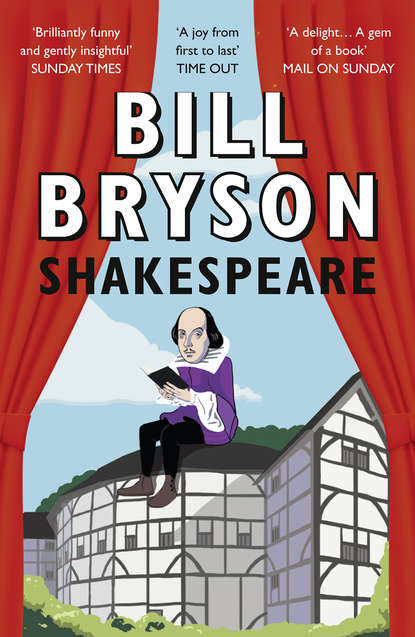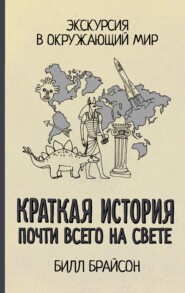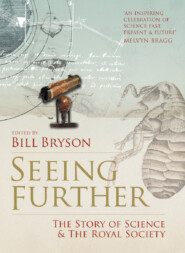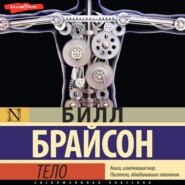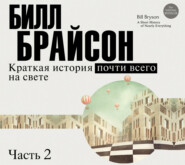По всем вопросам обращайтесь на: info@litportal.ru
(©) 2003-2025.
✖
Shakespeare
Настройки чтения
Размер шрифта
Высота строк
Поля
Shakespeare
Bill Bryson
From bestselling author Bill Bryson comes this compelling and concise biography of William Shakespeare, our greatest dramatist and poet.Examining centuries of myths, half-truths and downright lies, Bill Bryson makes sense of the man behind the masterpieces. As he leads us through the crowded streets of Elizabethan England, he brings to life the places and characters that inspired Shakespeare’s work, with his trademark wit and accessibility. Along the way he delights in the inventiveness of Shakespeare’s language, which has given us so many of the indispensable words and phrases we use today, and celebrates the Bard’s legacy to our literature, culture and history.Drawing together information from a vast array of sources, this is a masterful account of the life and works of William Shakespeare, one of the most famous and most enigmatic people ever to have lived – not to mention a classic piece of Bill Bryson, author of ‘A Short History of Nearly Everything’ and ‘Notes from a Small Island’.
Copyright (#ulink_198b10eb-7eb3-5934-98fa-bfd86c3b58e9)
William Collins
An imprint of HarperCollinsPublishers 1 London Bridge Street London SE1 9GF
www.harpercollins.co.uk
This HarperPress edition published 2008
First published in Great Britain by HarperPress in 2007
Copyright © Bill Bryson 2007
Bill Bryson asserts the moral right to be identified as the author of this work
A catalogue record for this book is available from the British Library
Find out more about HarperCollins and the environment at
www.harpercollins.co.uk/green
All rights reserved under International and Pan-American Copyright Conventions. By payment of the required fees, you have been granted the non-exclusive, non-transferable right to access and read the text of this e-book on screen. No part of this text may be reproduced, transmitted, downloaded, decompiled, reverse engineered, or stored in or introduced into any information storage and retrieval system, in any form or by any means, whether electronic or mechanical, now known or hereinafter invented, without the express written permission of HarperCollins e-books.
Ebook Edition © April 2012 ISBN: 9780007368969
Version 2016-04-22
This book is sold subject to the condition that it shall not, by way of trade or otherwise, be lent, re-sold, hired out or otherwise circulated without the publisher’s prior consent in any form of binding or cover other than that in which it is published and without a similar condition including this condition being imposed on the subsequent purchaser.
Table of Contents
Cover Page (#ud4a08867-3751-5585-9f3d-cde9dd3b5d9e)
Title Page (#u4e1b70b2-f5c1-5839-b359-1ccfcf76c0e4)
Copyright (#u12b1cc37-f8d2-513c-b982-88a7f3b9b4bb)
Dedication (#uf1d3f3e8-c440-5bcf-9f79-61725d365d6b)
Foreword (#u198f8170-16b0-5d7f-a33d-b6d7398b6fec)
Chapter One: In Search of William Shakespeare (#ucdb2e0a3-0199-5e48-a9fe-386bb0a05fe7)
Chapter Two: The Early Years, 1564–1585 (#u3bddfa2e-120b-5f13-aa16-aa09708a86fd)
Chapter Three: The Lost Years, 1585–1592 (#u8f21cf0f-e471-51cd-9cc9-210f7e2255de)
Chapter Four: In London (#litres_trial_promo)
Chapter Five: The Plays (#litres_trial_promo)
Chapter Six: Years of Fame, 1596–1603 (#litres_trial_promo)
Chapter Seven: The Reign of King James, 1603–1616 (#litres_trial_promo)
Chapter Eight: Death (#litres_trial_promo)
Chapter Nine: Claimants (#litres_trial_promo)
Select Bibliography (#litres_trial_promo)
Acknowledgements (#litres_trial_promo)
About the Author (#litres_trial_promo)
Praise (#litres_trial_promo)
By the same author (#litres_trial_promo)
About the Publisher (#litres_trial_promo)
To Finley and Molly and in memory of Maisie
Foreword (#ulink_6dbb0182-1ea5-576d-8357-5380db438a23)
A FEW YEARS AGO, a kindly New York publisher named James Atlas approached me out of the blue and asked me if I would like to write a biography for a series of books he was launching, to be called Eminent Lives.
Each book in the series was to be about forty thousand words, considerably less than half the length of a conventional biography. The idea was that each book would be long enough to have some substance while yet remaining concise.
James sent me a list of the subjects that had already been assigned. I was disappointed to find that nearly all the figures that jumped to my mind as candidates had already been taken. It was only when I went through the list a second time that I realized that no one had selected William Shakespeare, and impetuously I offered to take him on. To my surprise, and slight subsequent panic, James readily assented.
I hardly need point out that I am not a Shakespearean authority, but luckily Britain is full of people who are, and prudently I turned to them. The book that follows has almost nothing to do with what I think of William Shakespeare (though I admire him very much, of course), but is instead about what I learned of William Shakespeare from people who have spent lifetimes studying and thinking about him. I remain immensely grateful to them all, in particular to the great and scholarly Stanley Wells, now retired as chairman of the Shakespeare Birthplace Trust.
What is perhaps most extraordinary about William Shakespeare, bearing in mind that he has been dead for four hundred years, is how lively his world remains. Hardly a month goes by that there isn’t some fairly momentous claim or discovery relating to his life or work – never more so perhaps than in 2015 when a South African academic named Francis Thackeray suggested that Shakespeare may have filled the bowl of his little clay pipe with marijuana and possibly even cocaine. The assertion is based on an analysis of pipe remains found in the garden of New Place, Shakespeare’s last home in Stratford-upon-Avon. Never mind that nobody knows whether Shakespeare ever actually smoked a pipe or whether the pipe fragments belonged to him or his gardener or someone who owned the property later. Still, if it turns out that anybody in Elizabethan England was smoking cannabis and cocaine, that would be arresting news indeed, and it has to be said that no one would have examined the pipe fragments so fastidiously had there not been a Shakespeare connection.
Three other rather more notable events have bounced into the world of Shakespearean scholarship since this volume was first published and should perhaps be mentioned here. The most exciting – not to say incendiary – was the announcement in 2009 by the Shakespeare Birthplace Trust that it had acquired a new and definitive portrait of William Shakespeare.
Called the Cobbe portrait, it is the work of an unknown artist, and shows a youthful, rather dashing man of healthy complexion, dapper attire and a keen air of intelligence and sensitivity, all of which stands in sharp contrast to the other existing likenesses said to be of Shakespeare. The painting had previously hung in the Cobbe family’s ancestral home near Dublin and was long thought to be a portrait of Sir Walter Raleigh.
‘I was sceptical indeed to begin with,’ Stanley Wells told me at the time of the unveiling. ‘There are a lot of paintings that have been claimed to be of William Shakespeare on pretty dubious grounds. But the more I considered the evidence for this one, the more I grew persuaded. I would say I am 90 per cent convinced now it is genuine.’
It is a terribly exciting thought. Unfortunately, it has also encountered a good deal of criticism. Sir Roy Strong, the art historian, dismissed claims for the portrait’s authenticity as ‘codswallop’. Katherine Duncan-Jones of Oxford University thought the man in the portrait ‘too grand and courtier-like to be Shakespeare’, and in a long critical article for the Times Literary Supplement characterized the evidence as ‘not hugely compelling’. She suggested it was a portrait of a Sir Thomas Overbury.
At about the same time that the Cobbe portrait came to light, archaeologists from the Museum of London caused much scholarly excitement by announcing the discovery of the foundations of London’s first purpose-built theatre on the site of a disused warehouse in Shoreditch in east London. Built in 1576 and so indubitably original that it was called simply The Theatre, it is the oldest theatre positively associated with Shakespeare and was probably where Romeo and Juliet was first performed.
Bill Bryson
From bestselling author Bill Bryson comes this compelling and concise biography of William Shakespeare, our greatest dramatist and poet.Examining centuries of myths, half-truths and downright lies, Bill Bryson makes sense of the man behind the masterpieces. As he leads us through the crowded streets of Elizabethan England, he brings to life the places and characters that inspired Shakespeare’s work, with his trademark wit and accessibility. Along the way he delights in the inventiveness of Shakespeare’s language, which has given us so many of the indispensable words and phrases we use today, and celebrates the Bard’s legacy to our literature, culture and history.Drawing together information from a vast array of sources, this is a masterful account of the life and works of William Shakespeare, one of the most famous and most enigmatic people ever to have lived – not to mention a classic piece of Bill Bryson, author of ‘A Short History of Nearly Everything’ and ‘Notes from a Small Island’.
Copyright (#ulink_198b10eb-7eb3-5934-98fa-bfd86c3b58e9)
William Collins
An imprint of HarperCollinsPublishers 1 London Bridge Street London SE1 9GF
www.harpercollins.co.uk
This HarperPress edition published 2008
First published in Great Britain by HarperPress in 2007
Copyright © Bill Bryson 2007
Bill Bryson asserts the moral right to be identified as the author of this work
A catalogue record for this book is available from the British Library
Find out more about HarperCollins and the environment at
www.harpercollins.co.uk/green
All rights reserved under International and Pan-American Copyright Conventions. By payment of the required fees, you have been granted the non-exclusive, non-transferable right to access and read the text of this e-book on screen. No part of this text may be reproduced, transmitted, downloaded, decompiled, reverse engineered, or stored in or introduced into any information storage and retrieval system, in any form or by any means, whether electronic or mechanical, now known or hereinafter invented, without the express written permission of HarperCollins e-books.
Ebook Edition © April 2012 ISBN: 9780007368969
Version 2016-04-22
This book is sold subject to the condition that it shall not, by way of trade or otherwise, be lent, re-sold, hired out or otherwise circulated without the publisher’s prior consent in any form of binding or cover other than that in which it is published and without a similar condition including this condition being imposed on the subsequent purchaser.
Table of Contents
Cover Page (#ud4a08867-3751-5585-9f3d-cde9dd3b5d9e)
Title Page (#u4e1b70b2-f5c1-5839-b359-1ccfcf76c0e4)
Copyright (#u12b1cc37-f8d2-513c-b982-88a7f3b9b4bb)
Dedication (#uf1d3f3e8-c440-5bcf-9f79-61725d365d6b)
Foreword (#u198f8170-16b0-5d7f-a33d-b6d7398b6fec)
Chapter One: In Search of William Shakespeare (#ucdb2e0a3-0199-5e48-a9fe-386bb0a05fe7)
Chapter Two: The Early Years, 1564–1585 (#u3bddfa2e-120b-5f13-aa16-aa09708a86fd)
Chapter Three: The Lost Years, 1585–1592 (#u8f21cf0f-e471-51cd-9cc9-210f7e2255de)
Chapter Four: In London (#litres_trial_promo)
Chapter Five: The Plays (#litres_trial_promo)
Chapter Six: Years of Fame, 1596–1603 (#litres_trial_promo)
Chapter Seven: The Reign of King James, 1603–1616 (#litres_trial_promo)
Chapter Eight: Death (#litres_trial_promo)
Chapter Nine: Claimants (#litres_trial_promo)
Select Bibliography (#litres_trial_promo)
Acknowledgements (#litres_trial_promo)
About the Author (#litres_trial_promo)
Praise (#litres_trial_promo)
By the same author (#litres_trial_promo)
About the Publisher (#litres_trial_promo)
To Finley and Molly and in memory of Maisie
Foreword (#ulink_6dbb0182-1ea5-576d-8357-5380db438a23)
A FEW YEARS AGO, a kindly New York publisher named James Atlas approached me out of the blue and asked me if I would like to write a biography for a series of books he was launching, to be called Eminent Lives.
Each book in the series was to be about forty thousand words, considerably less than half the length of a conventional biography. The idea was that each book would be long enough to have some substance while yet remaining concise.
James sent me a list of the subjects that had already been assigned. I was disappointed to find that nearly all the figures that jumped to my mind as candidates had already been taken. It was only when I went through the list a second time that I realized that no one had selected William Shakespeare, and impetuously I offered to take him on. To my surprise, and slight subsequent panic, James readily assented.
I hardly need point out that I am not a Shakespearean authority, but luckily Britain is full of people who are, and prudently I turned to them. The book that follows has almost nothing to do with what I think of William Shakespeare (though I admire him very much, of course), but is instead about what I learned of William Shakespeare from people who have spent lifetimes studying and thinking about him. I remain immensely grateful to them all, in particular to the great and scholarly Stanley Wells, now retired as chairman of the Shakespeare Birthplace Trust.
What is perhaps most extraordinary about William Shakespeare, bearing in mind that he has been dead for four hundred years, is how lively his world remains. Hardly a month goes by that there isn’t some fairly momentous claim or discovery relating to his life or work – never more so perhaps than in 2015 when a South African academic named Francis Thackeray suggested that Shakespeare may have filled the bowl of his little clay pipe with marijuana and possibly even cocaine. The assertion is based on an analysis of pipe remains found in the garden of New Place, Shakespeare’s last home in Stratford-upon-Avon. Never mind that nobody knows whether Shakespeare ever actually smoked a pipe or whether the pipe fragments belonged to him or his gardener or someone who owned the property later. Still, if it turns out that anybody in Elizabethan England was smoking cannabis and cocaine, that would be arresting news indeed, and it has to be said that no one would have examined the pipe fragments so fastidiously had there not been a Shakespeare connection.
Three other rather more notable events have bounced into the world of Shakespearean scholarship since this volume was first published and should perhaps be mentioned here. The most exciting – not to say incendiary – was the announcement in 2009 by the Shakespeare Birthplace Trust that it had acquired a new and definitive portrait of William Shakespeare.
Called the Cobbe portrait, it is the work of an unknown artist, and shows a youthful, rather dashing man of healthy complexion, dapper attire and a keen air of intelligence and sensitivity, all of which stands in sharp contrast to the other existing likenesses said to be of Shakespeare. The painting had previously hung in the Cobbe family’s ancestral home near Dublin and was long thought to be a portrait of Sir Walter Raleigh.
‘I was sceptical indeed to begin with,’ Stanley Wells told me at the time of the unveiling. ‘There are a lot of paintings that have been claimed to be of William Shakespeare on pretty dubious grounds. But the more I considered the evidence for this one, the more I grew persuaded. I would say I am 90 per cent convinced now it is genuine.’
It is a terribly exciting thought. Unfortunately, it has also encountered a good deal of criticism. Sir Roy Strong, the art historian, dismissed claims for the portrait’s authenticity as ‘codswallop’. Katherine Duncan-Jones of Oxford University thought the man in the portrait ‘too grand and courtier-like to be Shakespeare’, and in a long critical article for the Times Literary Supplement characterized the evidence as ‘not hugely compelling’. She suggested it was a portrait of a Sir Thomas Overbury.
At about the same time that the Cobbe portrait came to light, archaeologists from the Museum of London caused much scholarly excitement by announcing the discovery of the foundations of London’s first purpose-built theatre on the site of a disused warehouse in Shoreditch in east London. Built in 1576 and so indubitably original that it was called simply The Theatre, it is the oldest theatre positively associated with Shakespeare and was probably where Romeo and Juliet was first performed.





